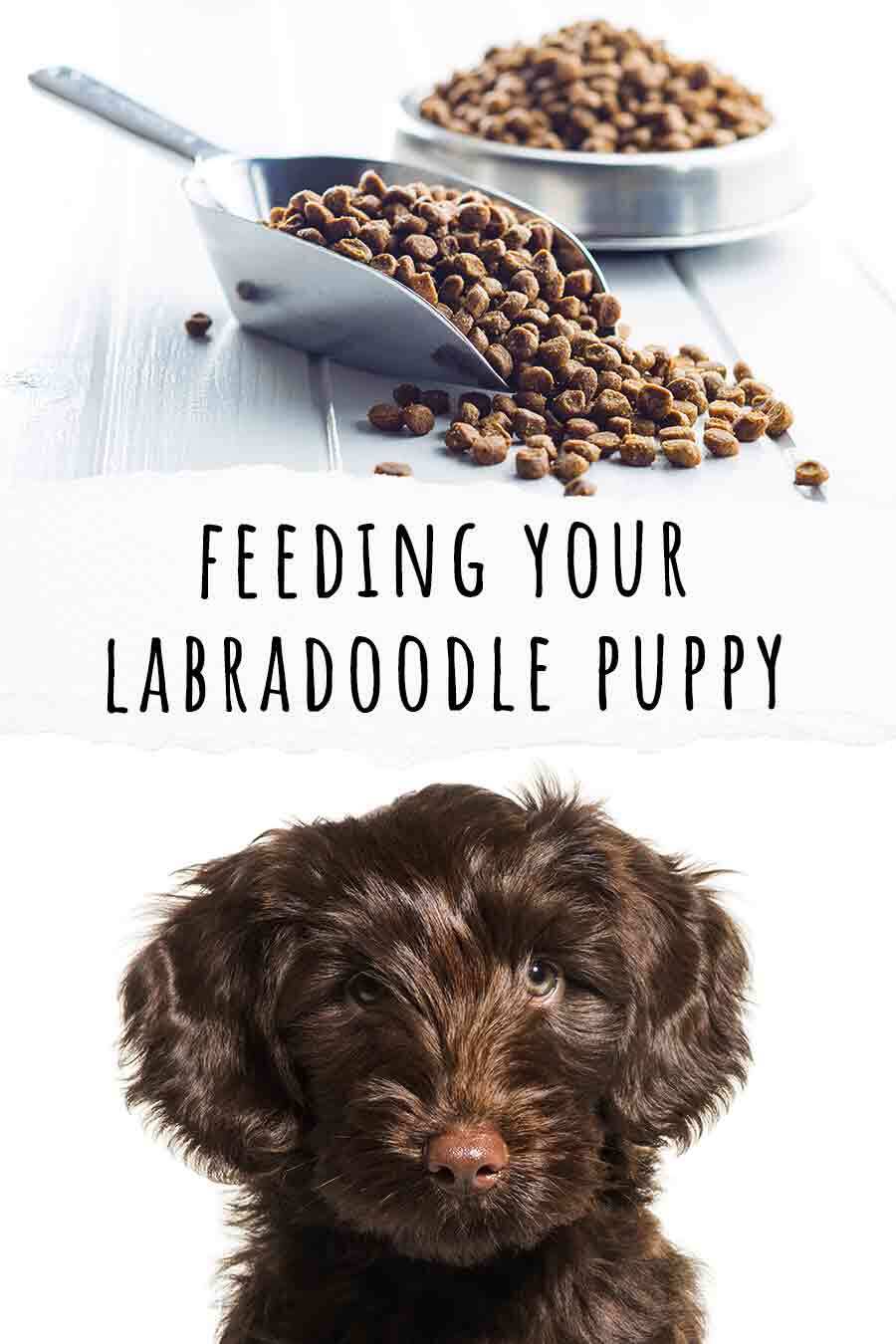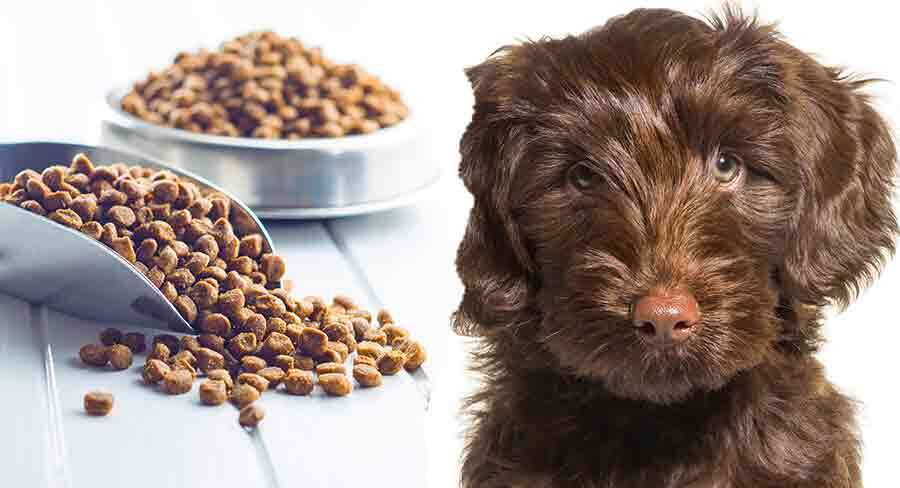Feeding your Labradoodle puppy the right diet involves finding a complete dog food aimed at puppies, and dividing their daily rations into several separate, evenly spaced meals throughout the day.
As they grow you will move from four meals per day at 8 weeks old, to just one or two in adulthood.
And you will want to use as much of their daily kibble as you can in training.
Helping to strengthen the bond between you, as well as to teaching them which behaviors you want to see in your home.
Feeding a Labradoodle Puppy
When it comes to feeding your new Labradoodle puppy there are plenty of options to choose between and a number of things to consider.
You’re probably wondering not only what to feed him, but how much and how often.
And since a puppy’s formative years can affect his health for life, you want to make the right choices.

Puppies grow up fast.
A Labradoodle that weighs 10lbs at 8 weeks old may be 60lbs or more by the time he’s a year old.
The first thing to keep in mind is that puppies have different dietary needs to adult dogs.
Puppy food is specifically formulated to support a young dog’s rapid growth and it’s important to never give your puppy an adult dog food formula.
Getting too much of some nutrients, and not enough of others can lead to developmental problems.
Puppy vs Adult Dog Digestion
Puppies’ dietary needs aren’t just about supporting healthy growth.
Growing pups digest food and absorb nutrients differently than adult dogs too.
Their gastrointestinal system also works much faster than that of an adult dog.
Finally, puppies don’t yet have all the digestive enzymes for breaking down carbohydrates and proteins that they’ll have by the time they’re grown up.
Puppy Nutrient Requirements
Puppies need more calories than adult dogs, relative to their size.
In fact, they need about twice as many calories in relation to their body weight compared to that of a full grown Labradoodle.
Compared to mature dogs, puppies also need:
- more protein to support growing muscle
- more fat to fuel growth
- and a different mineral balance to aid in the rapid development of their bones.
For example, one study showed that puppies fed a low phosphorus diet suffer from impaired appetite and growth, diminished skin and fur quality, and a disturbed musculoskeletal system.
Too much calcium can also negatively affect bone development, by accelerating it. If your puppy’s bone growth outpaces that of the cartilage in the joints it can cause serious problems, such as hip dysplasia.
This is a serious joint condition that leads to painful arthritis and lameness.
How Often Should I Feed My Labradoodle Puppy?
The smaller and younger your puppy is, the more often they need to eat, since their stomachs are too small for big portions. Your Labradoodle puppy’s schedule should reflect this.
Long gaps between meals can also cause hypoglycemia, which is when your puppy’s blood sugar drops too low.
Labradoodle puppies that are 4 months or younger should have their food split into 4 meals a day.
When they reach 4 and 6 months old this can be reduced to 3 meals.
And when they’re about 8 to 10 months you can reduce it again to 2 meals a day.
Commercial puppy foods base their feeding recommendations on ages and weight, so it’s a good idea to weigh your puppy weekly to monitor his growth.
How Much Should I Feed My Labradoodle Puppy?
Knowing how much to feed your Labradoodle puppy can be tricky.
Portion sizes don’t just depend on your puppy’s age and size, but also on how nutrient- and calorie-dense their food is.
So the feeding charts on the packaging are a good place to start.
Make sure you’re dividing the total daily total into the correct number of meals.
This basic pet calorie calculator can help determine how many calories a puppy needs.
Overfeeding Labradoodle Puppies
Canine obesity is a big problem for many dogs and the Labradoodle is no exception.
Some Labrador Retrievers are known to have a genetic mutation that causes them to have an insatiable appetite.
But there are plenty of genetically normal dogs who will always want more food.
If your puppy is constantly hungry you can try giving him smaller, more frequent meals.
In fact, for training purposes we recommend using as much of each of the meals rations as you can as training treats between meals.
It’s worth weighing out your puppy’s food for the day using a set of kitchen scales.
Studies have found that using a scoop or cup produces very inconsistent results, which can have a significant impact while they’re so young.
What Should I Feed My Labradoodle Puppy?
These days there are a lot of brands vying for space in the dog food market.
So deciding what to feed your Labradoodle puppy might be the most difficult question of them all.
Puppies that are 8 to 12 weeks old should continue eating the same food they were eating at the breeders.
If you want to change their food, wait until they are fully settled at home.
Then transition gradually to a different diet to avoid causing an upset tummy.
You can do it over the course of a week, like this:
- Feed 1 part new food to 3 parts old food on the first two days.
- Equal parts old food and new food on days three and four.
- And three parts new food to one part old food for two more days after that.
Feeding a Labradoodle Puppy Dry Food
Most puppy parents choose one of the many commercial dry puppy foods available.
There are many reasons why these diets (also known as kibbles) are so popular.
They are
- convenient
- relatively inexpensive
- easy to store
- helpful for maintaining clean teeth and healthy gums
- and easily handled for use as training treats.
But with so many types of kibble to choose from, there is a lot of variation in terms of quality.
So it’s really important to read the labels, and buy the best quality food you can afford.
Make sure a meat protein is listed as the first ingredient, and they food is AAFCO certified as being nutritionally complete.
And if in doubt, ask your vet for advice.
Feeding a Labradoodle Puppy Canned Food
Some puppies prefer wet food, since its high water content makes it smell good (at least to them!)
But it’s also more expensive than kibble, and doesn’t last as long once opened.
Another downside is that unlike kibble, it’s too messy to use as a treat during training.
There are also issues in regards to a puppy’s teeth. Soft, wet food has been associated with contributing to dental problems in dogs.
So when it comes to commercial foods, a high-quality specially-formulated dry puppy food is what vets will typically recommend.
Feeding a Labradoodle Puppy Homemade Food
These days more and more people are interested in feeding their pet a homemade diet.
Often there’s an assumption that they can cook healthier meals than commercial pet food brands offer.
However, studies have shown that these diets can be highly variable and often don’t meet the dog’s nutritional needs.
Inadequate canine nutrition can be detrimental to dogs in many ways.
This is especially true for growing puppies, whose well-being is so dependent on receiving the right diet.
If you are determined to give your pet a homemade diet, always consult with your vet first.
Related Articles
Feeding a Labradoodle Puppy
References and Further Reading
Weber et al. Influence of age and body size on gastrointestinal transit time of radiopaque markers in healthy dogs. National Center for Biotechnology Information. 2002.
Kiefer-Hecker et al. Effects of low phosphorus supply on the availability of calcium and phosphorus, and musculoskeletal development of growing dogs of two different breeds. Journal of Animal Physiology and Animal Nutrition. 2018.
Riches-Tomei JL. Update on hip and elbow dysplasia schemes. Veterinary Nursing Journal. 2011.
Raffan et al, “A Deletion in the Canine POMC Gene Is Associated with Weight and Appetite in Obesity-Prone Labrador Retriever Dogs,” Cell Metabolism, 2016.
Gossellin et al. Canine obesity: an overview. National Library of Medicine. 2007.
Idowu et al. Hypoglycemia in dogs: Causes, management, and diagnosis. Canadian Veterinary Journal. 2018.
Ohio State University Veterinary Medical Center. Basic Calorie Calculator. accessed January 2021.
Watson. Diet and periodontal disease in dogs and cats. Australian Veterinary Journal. 1994.
Larsen et al. Evaluation of recipes for home-prepared diets for dogs and cats with chronic kidney disease. Journal of the American Veterinary Medical Association. 2012.

